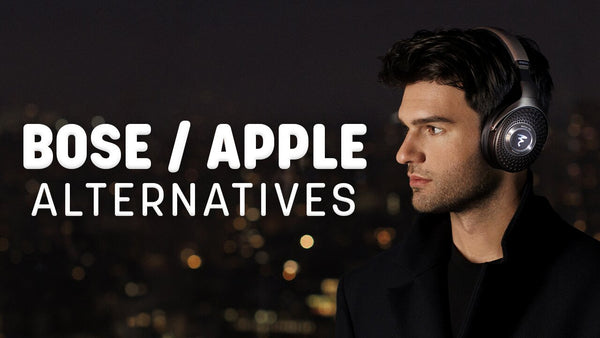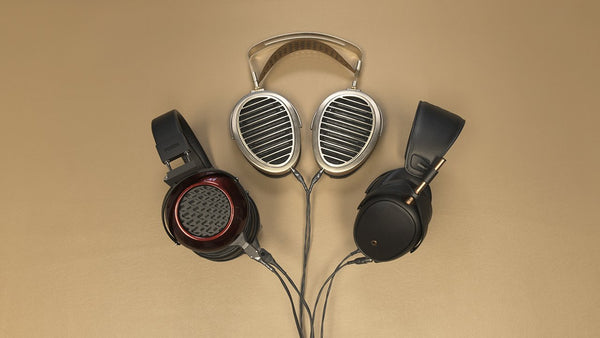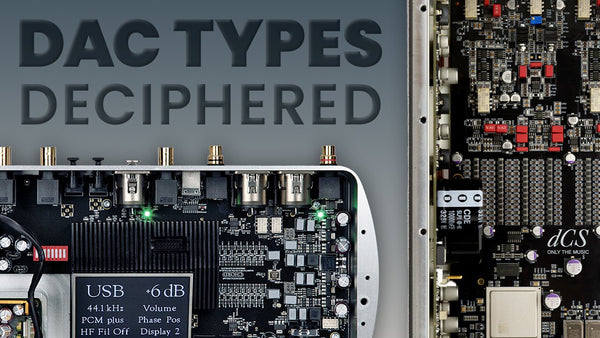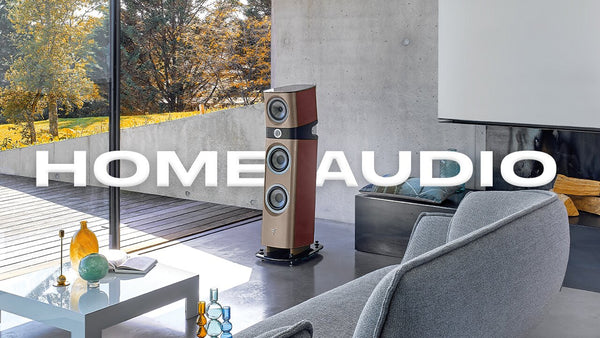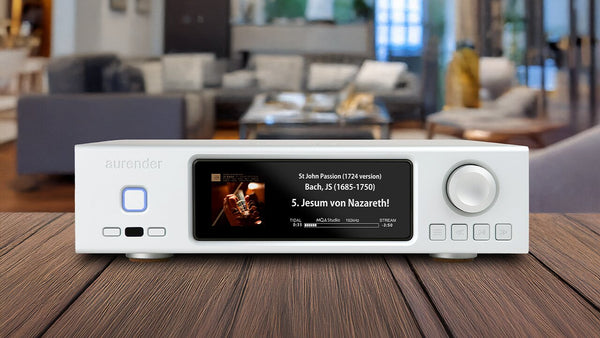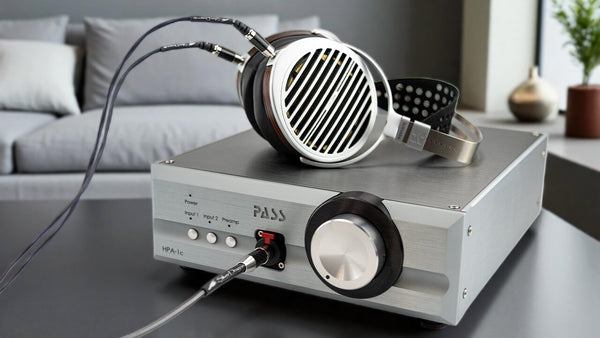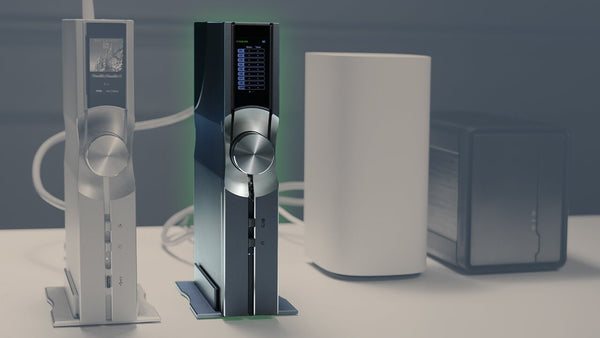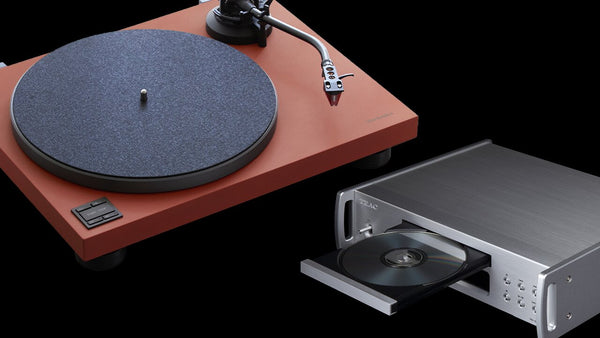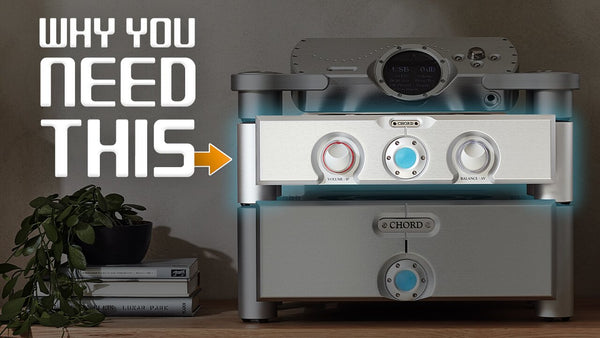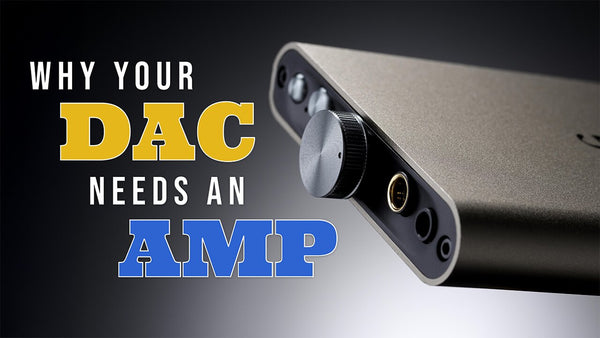TEAC UD-701N Music Player Review
Read Time: Approx. 24 min.

TEAC's Flagship Player Just About Does It All
The little black dress. It's the one thing that is suitable for all things formal. It's simple. It works. It looks nice. Well, gentlemen, I present to you... the little black box. It's suitable for all things. It does it all. It's simple. And it looks nice. It's TEAC's UD-701N Music Player. The flagship player from TEAC, it's a network player, a USB DAC, an analog preamp, and a headphone amplifier, plays everything, streams everything, and that's just the tip of the iceberg so to speak. Let's just say that I'm not going to have any shortage of things to say about this device.
Sporting a newly developed Delta Sigma discrete DAC, every digital signal is converted to the highest quality analog signal. Not only can it be used for all kinds of digital playback, from systems centered around a computer or server systems using a NAS, but it can also be configured to act as a standalone device with both analog and digital inputs. It pretty much has it all, so is there anything it can't do? Let's find out.
TEAC UD-701N Music Player Review
TEAC UD-701N Streaming Tutorial

PROS
- New discrete DAC sounds awesome
- Fully balanced
- Versatile do-it-all box
CONS
- Finish scratches easily
- Menu navigation could be improved
- HR Streamer App needs some UI overhaul
Design
There's much to be desired about the TEAC product design. I find it equally utilitarian and artistic: in the sense that it's a great-looking box despite the myriad of knobs and switches on the front panel. I'll admit, after reviewing the Naim Uniti Atom HE and going to a TEAC unit, there's a bit of stark contrast in the design elements and I might have been a little too harsh on the NT-505 design. They're just two VERY different user experiences. The UD-701N actually brings a lot of the functionality that I liked in the Naim Unit Atom and brings it to the all-in-one unit (but we'll get to that later). The front panel of the UD-701 is brushed metal, whereas the other sides of the product are a matte metallic finish. It's a striking design, although I would be careful with the matte sides as I'm sure they will be easy to scratch. The left and right sides of the TEAC are fins for heat dispersion, and they work appropriately well.
One design feature that TEAC implemented is a floating structure to keep the transformers, which can easily cause vibrations, isolated from the bottom panel. We all know that vibrations can affect audio quality, and TEAC has done a great job in minimizing the number of movable objects inside the device that could potentially be detrimental to the sound. In addition to using the minimum number of circuit board attachment screws, TEAC's original pinpoint feet utilize a new mechanism that provides protection on the bottom panel to suppress vibrations that ultimately affect audio quality. Even the length of the side fins of the device that are for heat dispersion have also been adjusted to prevent sympathetic vibrations.
Buttons, knobs, and switches are all premium with a satisfactory clicky-ness, and buttons, scrolls, and presses responded accurately. The resistance on the volume knob is pleasant, allowing for precise adjustments without much dead space. I really dislike scrolling knobs for volume adjustment and not having the level move if you don't rotate the wheel enough, and luckily this was never an issue with the UD-701N. Like the other UD series, TEAC installs 3 feet under their devices, two in the front and one centered in the rear of the unit. The feet are high-quality and balance the device well, while also minimizing complications from vibrations.
The menu settings are a bit clunky to sort through, but that's just mainly because the display screen can only show so many characters. I would have liked for easier navigation, but they did they best they could given the design elements provided. To scroll through the Output, Menu, and source selections, you'll need to press once on the corresponding button to enter the menu system. From there, use the source knob to navigate the menu items. To adjust a particular setting, you'll need to press the source knob again to enter into the submenu and adjust the settings according to your preferences. It's not a bad menu navigation system: it could be better and it could be a whole lot worse.
Menu Settings: Upconvert (Off, x2, x4, x8 Fs), Clock Sync (Off, DIN Async, DIN sync), XLR Out Polarity (Pin 2 Hot, Pin 3 Hot), Line Out Level (Variable, Off, Fixed 0dB, Fixed +6dB), Headphone XLR (Balanced, Active Ground), Dimmer (Bright, Slightly Bright, Dark, Auto-Off), Volume Type (Step 0-100, dB), Display Type (Sampling Freq, Volume), Auto Power Saving (Off, On), Delta Sigma Fs (512x Fs, 256x Fs, 128x Fs), PCM Delta Sigma (MultiBit, DSD 1-Bit), DSD Low Pass Filter (Off, Fir 1, Fir 2), Net Display Style (Player, Normal), Network (Enabled, Disabled), Version Info (System, USB, FPGA, Bluetooth, Network).
Source Selections: LINE RCA > LINE XLR > USB > COAXIAL 1 > COAXIAL 2 > OPTICAL 1 > OPTICAL 2 > NETWORK > BLUETOOTH
Output Selections: Phones Balanced > Phones Unbalanced > Line Out RCA > Line Out XLR
Sound
Yeah, it's good. TEAC’s discrete Delta Sigma DAC is surprisingly organic – providing a plethora of detail but not chintzy on the low end either. For my testing setup, I paired the UD-701N with the Meze Audio Elite Headphones and a Black Dragon premium cable. The Elite does well to show off the detail and dynamic range, and the TEAC performs effortlessly.
On the signature spectrum, Delta Sig isn’t as forward as FPGA DAC circuitry, but it's definitely on the forward side. This is not to be construed with a negative connotation: products are either forward, neutral, or warm. R2R DACs or AKM off-the-shelf chips provide a much warmer and musical presentation, and while TEAC’s discrete design retains some nice bottom-end presence, it’s the hyper-detail, analog-seeking sound that really stands out. Some might call it analytical, but the headphone or speaker pairing can make or break the deal. Luckily, the 701 pairs well with almost everything. Particular genre favorites were jazz and classical, classic rock, folk, and singer-songwriter. Anything that had an organic sound to it came alive. Bowed instruments you can hear the hair rub against the strings, the same with picked instruments like acoustic guitar and mandolin. The TEAC makes these sounds natural and resonant. Even the crunch of classic electric rock was impressive in the sense that the overdriven tubes in the recordings could be FELT.
Paired with the Meze Elite headphones made for a pretty epic experience I will say. Even the black dragon cable pairing helped to bring out some extra low-end and mid-range that made the signature a little more toasty without covering up the clarity of the UD-701N or Elite. As always when it comes to cables, feel free to contact us with your headphone information and we’ll be more than happy to make a personalized recommendation just for you.
Speaking of some amazing guitar crunch, some of the best guitar tones I've heard come out of recent new music is from Brandi Carlile's new song Broken Horses. On top of some solid rock vocals, the power resides in the electric guitar entrances and the aggressive strumming of the acoustic. When the chorus vocals come in, it really shows off the soundstage with some wide panning of the voices in the mix. Also, the light bell-like picking of the instruments with the light piano behind this section do well to show off the detail and depth of the UD-701N's sound.
TEAC's discrete DAC continues this clarity kick even with Oasis' All Around the World, which is usually a wall of noise through any lesser system, with the multiple tracked guitars becoming a cluttered and mumbled mess, especially in cheaper, consumer-grade headphones and speakers. The discrete Delta Sigma DAC shows off a lot of this layering that is missed, and instead of sounding like a mess of sound, you can hear the panned guitar parts as a sort of soundscape, providing some nice texture as well. Vocals still stand out on the top of the mix, the gravel and voice breaks lending an honest performance that marries well with the distorted guitars.
If I had to sum it up, I was very impressed with TEAC's sound in their 505 unit, and the 701 simply blows that out of the park. It's deserving of the TEAC name, and although I would classify it as a little more forward than the 505, it's the clarity that set the bar to a new high. Of course, combining the music player with the Meze Elite is a superb pairing, but even with other headphones like the Focal Stellia and the Meze Liric, the TEAC UD-701N is versatile and organic enough to bring out the best sound in your headphone, no matter what the make or model.

Broken Horses
By Brandi Carlile
(In These Silent Days)

Montezuma
By Fleet Foxes
(Helplessness Blues)

Butterfly's Day Out
By Yo-Yo Ma, Edgar Meyer, Mark O'Connor
(Appalachian Waltz)

All Around the World
By Oasis
(Be Here Now)
Features
TEAC Delta Sigma discrete DAC - TEAC likes to do things their own way. And they're good at it, so there's no surprise that instead of using a generic DAC IC like AK or ES, they've developed their own chip that is comprised of discrete circuitry using FPGA incorporating their original algorithms. Analog signals are outputted with high-quality audio, DSD (22.5MHz) signals are transmitted without issue as is, and PCM (384kHz/32-bit) signals are sent after passing through a Delta Sigma modulator and conversion to 1-bit signals. It's impressive, to say the least, and TEAC is proud of its sonic performance given its unique discrete DAC design. As they put it, "We can say that achieving this wide, perfectly clear sound field, which can be realized specifically because of the discrete design, is TEAC reaching the pinnacle of its sound objectives."
Fully-Balanced - The fully balanced transmission of both the left and right analog output signals from after D/A conversion through the final output stage contributes greatly to improving the signal-to-noise ratio and increasing the dynamic range. This conveys signals in a purer state without losing the sense of air that high-resolution audio sources have. Balanced audio is not always better than single-ended - you can read more about that in our guide HERE - but in this case, TEAC's balanced circuitry does get the preferred treatment over the single-ended output, as dynamics are noticeably improved and resolute.
The 4-pin XLR headphone amplifier can also be switched between balanced and active ground. Active ground is a drive method, based on the principles of a balanced connection, that approaches 0V by connecting the COLD connector to the ground and driving the ground forcibly using an amplifier circuit. Not only can a more ideal ground be realized than when using an ordinary ground, the impact of humming noise coming from the power can also be suppressed. Moreover, by lowering the noise floor, you can expect silence to be deepened, allowing the breathing of the artists and the texture of sounds to be felt more intimately. Ultimately, this enables the amplifier to drive a number of different headphones with various impedance ratings, both low and very high. The inclusion of four toroidal core transformers are also integrated into the design of the UD-701N, two for the independent left and right analog signals, as well as separate transformers for both the network module and digital control sections. This ensures that reliable power is reaching the most integral sections of the unit for peak performance.
Analog Preamplifier - The UD-701N can also work as a high-quality analog preamplifier by employing additional analog audio inputs via the RCA and XLR connectors in the rear that allow users to connect conventional audio sources. TEAC employs a variable gain amp volume control with four independent circuits for left, right, positive, and negative. Designing it in this manner creates a much shorter signal path, preventing audio degradation over longer distances. Also, since the volume can be adjusted in very small 0.5db intervals, this fine volume control is ideal for both headphones and any other audio system you might have.

Streaming
I have to say one of the most impressive aspects of the UD-701N to me is the amount of streaming and wireless functionality for high-resolution audio - it's something I've not come across in an all-in-one before. Previously, the Naim Uniti Atom won the prize for streaming options, but the TEAC ups the game with HD codecs, OpenHome, as well as Bulk pet USB transfer. It's a versatile device that has lots of streaming service integration that makes for a robust and capable streamer, apart from everything else that's packed into the music player.
There are a couple of options when it comes to streaming music on the TEAC UD-701N player: Network and Bluetooth. Bluetooth is the more straightforward configuration if you want to have music streamed from a connected device like your phone, you will be able to output that audio to the headphones or designated outputs on the TEAC player. the UD-701N is also able to connect via high-resolution codecs like LDAC, LHDC, and Qualcomm aptX HD which is capable of 48 kHz / 24-bit audio transmission. Of course, the popular AAC, Qualcomm aptX, and SBC codecs are also supported so you can enjoy almost any device connection among these available codecs. Keep in mind that when connecting and pairing devices via Bluetooth, you'll be constrained to matched Bluetooth codecs per device. So for instance, if your phone can connect via LDAC, then you'll be able to transmit high-resolution audio. If your device can only connect via AAC and SBC you will not be able to transmit high-resolution audio since you will be constrained by the lowest available codec. It's also important to note that Bluetooth connections on the TEAC UD-701N are only for music sources, such as a phone or tablet where you can connect a remote or streaming library. You cannot connect to wireless headphones as the only audio outputs on the music player are the XLR, 3.5mm, and line out options.
To pair the UD-701N to a Bluetooth device, select Bluetooth as the source. It’ll say check, so click the source button again and it will say no device paired. To place the TEAC into pairing mode, simply hold down the source button for a few seconds until pairing mode is enabled. Remember, you can select hosts like your phone or tablet to pair as a music source but not audio output to a pair of wireless headphones.
Common control apps that support OpenHome can be used with the UD-701N, which also supports this platform. Moreover, playlists on the UD-701N can be managed using TEAC HR Streamer and other control apps that support OpenHome. Gapless playback is also supported. With support for Roon Ready, functions provided by RAAT (Roon Advanced Audio Transport), including high-quality audio playback, easy and convenient operation using apps, and multi-room synchronized playback can be used without limits. The HR Streamer application can be downloaded from the Google Play and Apple stores. In order to work with the application, you'll need to set the TEAC player to the Network source, make sure the player is connected to the preferred network, and then open the application.
HR Music Streamer Application Walkthrough
Once the application is open, click on the gear icon in the top right to select your setup settings. Under the options, you'll find (in order), where to select your music player - in this case, it would be the TEAC UD-701N. Under there you'll be able to set your options in regards to naming the unit, logging into your streaming applications, and checking for firmware updates for the device. Next, you'll be able to select the source of the music library you'll be accessing. Under those options, you can choose to reload or update the library settings as well as configure remote access if you desire. "Operation" settings allow you to customize how you interact with the application and "Appearance" edits the look and layout of the application based on your preferences.
Outside of the settings, you'll find 5 icons allowing you to select the streaming service: local or remote files, Tidal, Qobuz, Internet Radio, and Spotify. From there you can select and browse music based on the submenus for each source. Continuing right from the icons, there will be two boxes letting you select if you want to view the menus in a tile format or list. Next over is the settings "gear" icon, and then you have the option to enlarge or minimize the menu window. Minimizing this window will allow you to access the play and skip controls, as well as the volume, playlist settings, and overall control of your playback. Maximizing the menu window will make for easier browsing and navigation of your music and streaming options.
All in all, the application needs refinement, but it is at least functional. Understanding the basic layout and functions is half the battle. Once you know where things are, it works as expected. Personally, I prefer the layout and UI of Roon over the HR app, but at least it's another option for you to access your streaming services and more if you need. It works, and that's what's important.
Dragon Cables
[Silver Dragon USB Cable, Black Dragon Interconnect Cable, Black Dragon Power Cable]
There are a lot of reasons why you need to make sure your audio cables are not afterthoughts.
Our HiFi Audio Dragon Cables bring out more of what you love in your music and audio gear. If you love your headphones but wish they had a bit more top-end sparkle - a Silver Dragon Headphone Cable would be a great option. If your USB cables keep dying - as many stock cables do - then check out our quality USB Audio Cables. We say time and time again that materials matter, and our audio cables and custom geometries actually help to bring out those desired properties in your gear and music. We make tons of custom options for our customers so that you can get the right HiFi Audio cable for your exact needs. If you have any questions feel free to Contact Us and we'll be more than happy to help.
Verdict
Ultimately, the TEAC UD-701N is an impressive little black box. The design is sleek, and is a great option for a Roon Ready endpoint or for those who rely heavily on streaming services - and it will especially help you get the most out of your higher-resolution streaming audio. One of the biggest draws to the unit however is the fully balanced circuitry combined with the Delta Sigma discrete DAC. The sound is superb, and combined with a resolute headphone, makes for an outstanding standalone system. Of course, you can configure it as a single element in your system as well, either a designated streamer source, an analog preamp, a USB DAC, etc; it's an incredibly versatile device that excels at each individual component, not just the unit as a whole. If you’re looking for a music player that does it all, then the TEAC UD-701N is a solid choice that we give a big thumbs up to. The internal design, discrete DAC, great sound, and even more impressive functionality with streaming integration, wireless and high-resolution Bluetooth codecs make the UD-701N a little black box that deserves a designated shelf in your system.
Featured Products
Related Videos
TEAC UD-701N Music Player Review
TEAC UD-701N Streaming Overview Video
TEAC CD Player Comparison: VRDS-701, VRDS-701T, & PD-505T
What's in the Box
Specifications
Technical Features
- DAC SECTION
- DAC: TEAC ΔΣ Discrete DAC × 2
- Upconvert: 2xFs / 4xFs / 8xFs (maximum 384kHz)
- ANALOG AUDIO INPUTS
- Balanced
- Connectors: XLR × 1 pair
- Input impedance: 50kΩ
- Maximum input level: 5Vrms
- Unbalanced
- Connectors: RCA Pin (gold-plated) × 1 pair
- Input impedance: 25kΩ
- Maximum input level: 2.5Vrms
- DIGITAL AUDIO INPUTS
- USB
- Connectors: USB B-type × 1, (USB2.0 compliant)
- Supported Formats:
- PCM 16 / 24 / 32bit
- 44.1k / 48k / 88.2k / 96k / 176.4k / 192k / 352.8k / 384kHz
- DSD 2.8M / 5.6M / 11.2M / 22.5MHz
- Coaxial
- Connectors: RCA Pin (god-plated) × 2 pairs
- Input level: 0.5Vp-p
- Input impedance: 75Ω
- Supported Formats:
- PCM 16 / 24bit
- 32k / 44.1k / 48k / 88.2k / 96k / 176.4k / 192kHz
- DSD 2.8MHz (176.4kHz/24bit DoP format)
- Optical
- Connectors: Rectangular (TOS) × 2 pairs
- Input level: –24.0 to –14.5dBm peak
- Supported Formats:
- PCM 16 / 24bit
- 32k / 44.1k / 48k / 88.2k / 96k / 176.4k / 192kHz
- DSD 2.8MHz (176.4kHz/24bit DoP format)
- ETHERNET
- Connector: RJ-45 × 1 (1000Base-T)
- Bluetooth®
- Bluetooth® Version: 4
- Output Class: Class2 (rrange: 10m)
- Supported Profile: A2DP, AVRCP
- Supported A2DP Codec: LDAC, LHDC, AAC, SBC, Qualcomm®aptX™ audio/HD audio
- A2DP Content Protection: SCMS-T
- Number of saved pairings: Maximum 8
- Supported Formats:
- PCM 16 / 24 / 32bit
- 32k / 44.1k / 48k / 88.2k / 96k / 176.4k / 192kHz / 352.8k / 384kHz (Stereo)
- DSD 2.8M / 5.6M / 11.2M / 22.5MHz (Stereo)
- Supported Formats:
- PCM lossless FLAC, Apple Lossless (ALAC), WAV, AIFF, MQA
- DSD lossless DSF, DSDIFF (DFF), DoP
- Compressed audio MP3, AAC (m4a container)
- USB FLASH DRIVE
- Connectors: USB A-type × 2 (Front × 1, Rear × 1, USB2.0 compliant)
- Supported File System: FAT32, exFAT and NTFS single partation
- Supported File Format:
- PCM 16 / 24 / 32bit
- 32k / 44.1k / 48k / 88.2k / 96k / 176.4k / 192kHz / 352.8k / 384kHz (Stereo)
- DSD 2.8M / 5.6M / 11.2M / 22.5MHz (Stereo)
- Supported File Formats:
- PCM lossless FLAC, Apple Lossless (ALAC), WAV, AIFF, MQA
- DSD lossless DSF, DSDIFF (DFF), DoP
- Compressed audio MP3, AAC (m4a container)
- ANALOG AUDIO OUTPUTS
- Balanced
- Connectors: XLR (gold-plated pins) × 1 pair
- Output impedance: 220Ω
- Output level settings: Selectable from Fixed (0dB), Fixed (+6dB), Variable, or Off
- Maximum output level:
- 2.0Vrms (1kHz, Full-scale, 10kΩ loaded, FIxed at 0dB)
- 4.0Vrms (1kHz, Full-scale, 10kΩ loaded, FIxed at +6dB)
- 12Vrms (1kHz, Full-scale, 10kΩ loaded, Variable)
- Unbalanced
- Connectors: RCA Pin (gold-plated) × 1 pair
- Output impedance: 180Ω
- Output level settings: Selectable from Fixed (0dB), Fixed (+6dB), Variable, or Off
- Maximum output level:
- 2.0Vrms (1kHz, Full-scale, 10kΩ loaded, FIxed at 0dB)
- 4.0Vrms (1kHz, Full-scale, 10kΩ laoded, Fixed at +6dB)
- 6.0Vrms (1kHz, Full-scale, 10kΩ loaded, Variable)
- HEADPHONE OUTPUTS
- Balanced
- Connector: 4-pin XLR × 1
- Pin asign: Pin1: L+, Pin2: L–, Pin3: R+, Pin4: R–
- Unbalanced
- Connector: 6.3mm Stereo jack (gold-plate) × 1
- Maximum output power:
- Balanced: 700mW + 700mW (32Ω loaded)
- Unbalanced: 500mW + 500mW (32Ω × 1 loaded)
- Supported impedance: 16 to 600Ω
- Clock sync input:
- Connector: BNC (gold-plated) × 1
- Input frequency: 10MHz
- Input impedance: 50Ω
- Input level:
- Rectangle wave: Equivalent to TTL
- Sine wave: 0.5 to 1.0Vrms
- External control:
- Trigger Input: (12V TRIGGER IN)
- Connector: 3.5mm Mono mini jack × 1
- Input level: 12V, 1mA
- Trigger output: (12V TRIGGER THRU)
- Connector: 3.5mm Mono mini jack × 1
- Output level: 12V
- Maximum current supply: 100mA
- Audio performance: *Measurement conditions: Input signal: 192kHz/24-bit PCM, Measurement output: RCA, DAC low-pass filter: On
- Frequency response: 5Hz to 80,000Hz (+1dB/–5dB)
- Total harmonic distortion: 0.01% (1kHz, LPF: 20 to 20kHz)
- S/N ratio: 110dB (A-Weight, IHF-A)
- Power:
- AC120V, 560Hz (US/Canada)
- AC230V, 50Hz (UK/Europe)
- Power consumption: 40W
- Standby power: 0.4W
- Overall dimensions: 444 (W) × 111 (H) × 334 (D) mm (including protrusions)
- Weight: 11.8kg
- Operating Temperature: +5℃ to +35℃
- Operating Humidity Range: 5% to 85% (no condensation)
- Storage Temperature Range: –20℃ to +55℃

















